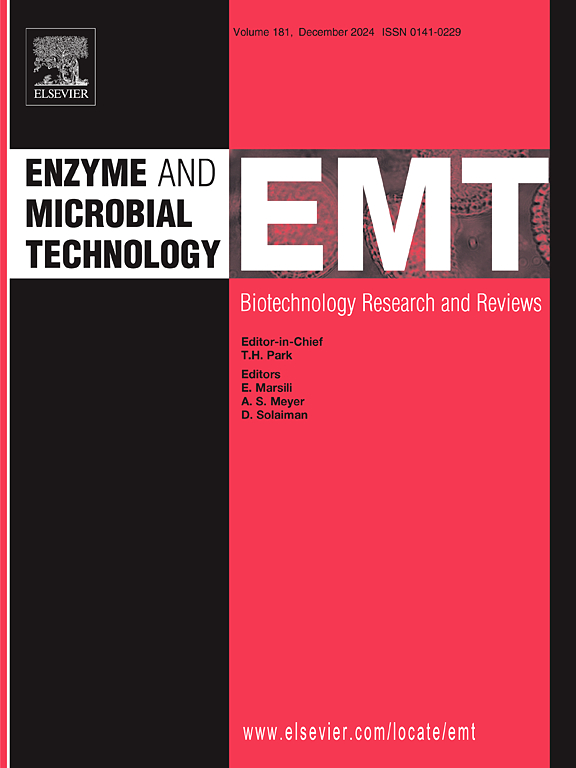山茶黄杆菌Dolsongi-HT1角化酶的鉴定及其对皮肤去角质的作用
IF 3.7
3区 生物学
Q2 BIOTECHNOLOGY & APPLIED MICROBIOLOGY
引用次数: 0
摘要
角蛋白是保护我们皮肤的最外层,有一个适当的更新周期。随着年龄的增长,角蛋白转换周期开始出现功能障碍。为了克服这个问题,我们人工去除死皮细胞。在这项研究中,我们试图筛选可能对化妆品行业有用的酶,以开发适合酶基方法的酶,这是一种不损害皮肤的温和去角质方法。从产自济州岛道松溪茶园的绿茶中分离到具有溶角蛋白活性的茶绿杆菌dolsoni - ht1。在培养基中检测了山茶茶Dolsongi-HT1的角化酶活性,表明目标角化酶是一种分泌蛋白。用前臂皮肤角蛋白和重建的人体皮肤模型证明了角蛋白溶解活性。山茶C. camelliae Dolsng-HT1酶(HT1)能有效分解人皮肤角蛋白。此外,利用重建的人体皮肤模型进行的实验表明,HT1能有效地去除最外层角质层的角质。与常用的化学去角质方法相比,HT1酶促去角质的磨蚀性较小,且不损伤表皮层。用蛋白纯化和质谱法鉴定角朊酶。鉴定的酶(iHT1)在枯草芽孢杆菌RIK 1285分泌蛋白表达系统中表达。iHT1酶在30 ~ 60℃的较宽温度范围内表现出较高的活性,在30℃时活性最高。iHT活性的最适pH为pH8。本文章由计算机程序翻译,如有差异,请以英文原文为准。
Characterization of keratinase from Chryseobacterium camelliae Dolsongi-HT1 and efficacy on skin exfoliation
Keratin is the outermost layer that protects our skin and has an appropriate turnover cycle. With age, the keratin turnover cycle begins to dysfunction. To overcome this issue, we artificially remove dead skin cells. In this study, we attempted to screen enzymes that could be useful in the cosmetics industry to develop enzymes suitable for the enzyme-based method, a mild exfoliation method that does not damage the skin. Chryseobacterium camelliae Dolsongi-HT1 with keratinolytic activity was isolated from green tea leaves (sourced from the Dolsongi tea garden, Jeju Island). The keratinolytic activity of C. camelliae Dolsongi-HT1 was detected in the culture media, indicating that the target keratinolytic enzyme is a secreted protein. Keratinolytic activity was demonstrated using forearm skin keratin and reconstituted human skin models. The enzyme from C. camelliae Dolsng-HT1 (HT1) could efficiently decompose human skin keratin. Moreover, experiments using the reconstituted human skin model demonstrated that HT1 is efficient in exfoliating the outermost stratum corneum. Compared with the popularly used chemical exfoliation method, enzymatic exfoliation using HT1 was less abrasive and did not damage the epidermal layer. Keratinolytic enzyme was identified using protein purification and mass spectrometry. The identified enzyme (iHT1) was expressed in the Bacillus subtilis RIK 1285 secretory protein expression system. The iHT1 enzyme showed high activity over a wide temperature range (30–60 °C), with the highest activity at 30 °C. The optimum pH for the activity of iHT was pH8.
求助全文
通过发布文献求助,成功后即可免费获取论文全文。
去求助
来源期刊

Enzyme and Microbial Technology
生物-生物工程与应用微生物
CiteScore
7.60
自引率
5.90%
发文量
142
审稿时长
38 days
期刊介绍:
Enzyme and Microbial Technology is an international, peer-reviewed journal publishing original research and reviews, of biotechnological significance and novelty, on basic and applied aspects of the science and technology of processes involving the use of enzymes, micro-organisms, animal cells and plant cells.
We especially encourage submissions on:
Biocatalysis and the use of Directed Evolution in Synthetic Biology and Biotechnology
Biotechnological Production of New Bioactive Molecules, Biomaterials, Biopharmaceuticals, and Biofuels
New Imaging Techniques and Biosensors, especially as applicable to Healthcare and Systems Biology
New Biotechnological Approaches in Genomics, Proteomics and Metabolomics
Metabolic Engineering, Biomolecular Engineering and Nanobiotechnology
Manuscripts which report isolation, purification, immobilization or utilization of organisms or enzymes which are already well-described in the literature are not suitable for publication in EMT, unless their primary purpose is to report significant new findings or approaches which are of broad biotechnological importance. Similarly, manuscripts which report optimization studies on well-established processes are inappropriate. EMT does not accept papers dealing with mathematical modeling unless they report significant, new experimental data.
 求助内容:
求助内容: 应助结果提醒方式:
应助结果提醒方式:


